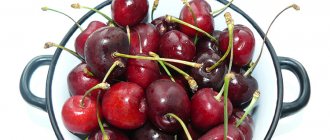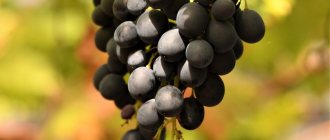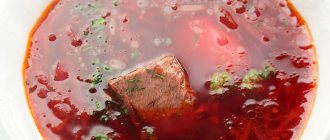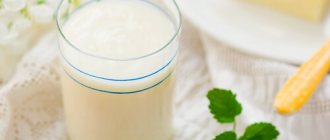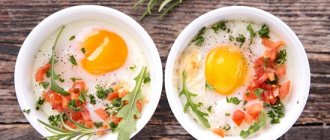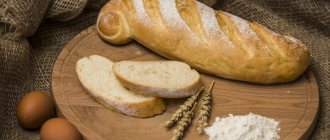Rice is one of the most widespread grain crops on the globe and the main one in the countries of East and Southeast Asia. Along with this, it also has the lowest calorie content among them and is enriched with many useful microelements and vitamins (especially brown rice). Due to this, nutritionists include it in many weight loss diets. For this reason, many dietary dishes containing rice take their origins from the traditional cuisine of China or Japan.
How many calories are in rice
To calculate the amount of rice required for consumption, you need to know its energy value. It varies depending on what type it is: dry or cooked, boiled, steamed or fried, cooked with meat or vegetables, as a filling for pies or in milk porridge.
| Kinds | White | Brown | Black | Wild | Red | Basmati |
| dry | 344 | 337 | 285 | 360 | 330 | 350 |
| boiled | 116 | 110 | 95 | 100 | 98 | 111 |
As part of the dishes
| Dish | Calorie content, per 100g in kcal |
| Porridge on the water | 78 |
| Porridge with milk | 97 |
| Rice with vegetables | 189 |
| Stuffed peppers with meat and rice | 95 |
| Chicken soup with rice | 90 |
| Stuffed cabbage rolls with meat and rice | 220 |
| Meatballs with rice | 154 |
| Salad with rice and crab sticks | 196 |
All figures given are approximate and are based mainly on the lower and middle limits of the calorie content level. It is possible to calculate their exact number when the specific type of rice, its quantity used in preparation, and the cooking method are known. The energy value of dry rice is always indicated on the packaging, so it is not difficult to determine it. It is worth keeping in mind that:
- steamed rice has about half the calorie content of raw rice;
- when cooking and stewing, rice significantly loses its energy value, approximately 3 times;
- when frying (which in any case is only possible after boiling or steaming), its value approximately doubles, i.e. up to 2/3 of its original calorie content. This happens due to vegetable fats coming from the oil. Moreover, it is also important what kind of oil it is and what its calorie content is.
Whatever foods are added to dishes, their calorie content invariably affects the calorie content of the dish. The more ingredients and the higher their value, the “heavier” the dish. Therefore, porridges are the least calorie-rich. Porridge with water (without everything) is the “lightest” - around 80 kcal, with the addition of milk or sugar it ranges from 100-120 kcal. When stewing and boiling with meat and vegetables – 90-150 kcal. If you cook rice with vegetables, cabbage rolls with meat and rice, or meatballs, then due to the presence of frying during the cooking process, their energy value on average increases to 200 kcal.
Rice with chicken and vegetables
As well as salt and spices (basil, mixed peppers, oregano, etc.), herbs for serving.
Change the type of rice to suit your taste.
The dish can be prepared from frozen vegetables.
Chicken meat can be used from any part of the carcass. If the meat has been frozen, it should be defrosted in the refrigerator.
Appliances : stove, microwave (oven).
Preparing Ingredients
| Peel the eggplant and cut into strips. Immerse in cold water for 40-60 minutes. |
| Boil the rice until half cooked. Drain the water. |
| Mince the chicken meat with onion (1 piece) and garlic or cut into small pieces (chop the onion and garlic with a knife). Salt and add spices to taste. If you have ready-made frozen minced meat, it should be thawed in the refrigerator in advance. |
| Finely chop the remaining onion. |
| Grate the carrots on a coarse grater. |
| Remove seeds from pepper and cut into small cubes. |
| Remove the skin from the tomato and cut into cubes. You can see how to peel tomatoes without boiling water in the recipe “Stuffed Eggplants Imam Bayaldy.” |
Cooking
| Drain the water from the eggplants, squeeze them lightly and dry (so that the oil does not splash when frying). Fry the pieces in hot oil over high heat until golden brown. |
| Add onion and fry until translucent. |
| Add carrots and pepper. Cook for 5-7 minutes. |
| Add tomatoes and fry for another 10 minutes. Add salt, spices, vinegar, sugar and cook for about 5 minutes. |
| Grease the bottom of the baking dish with vegetable oil. |
| Place rice. |
| Then minced meat. |
| Place vegetables on top. Pour in 1 tbsp. hot water, or better yet broth. |
| Heat the milk. |
| Prepare the sauce. Mayonnaise lovers can use it, but the taste will be different. Pour 2 tbsp into the pan. vegetable oil (can be replaced with butter). Add flour and mix with butter (preferably with a fork). |
| Carefully pour in the milk. |
| Stir and bring to a boil. Cook, stirring, until it begins to thicken. Instead of milk, you can use cream diluted with water. You can pour in the broth and add sour cream. |
| Salt the semi-liquid sauce and add spices to taste. Cook until it reaches the consistency of sour cream. |
| Pour the sauce evenly over the vegetables. |
| Microwave until the minced meat and rice are cooked. High mode - 5 minutes, medium - 20 minutes, oven exposure - 10 minutes. If using an oven, cook for 40 minutes at 180 degrees. |
| Let the casserole cool slightly and serve. All layers should stick together well and you can cut the casserole like a cake. Place the portions on a plate with the wide side of the piece, in the form of a pyramid, and sprinkle with finely chopped herbs. |
What are the benefits of rice?
Rice contains 78g of carbohydrates, 1.5g of fat and 6.7g of protein per 100g. Thanks to the high saturation of complex carbohydrates, a feeling of satiety is maintained for a long time, and the muscles receive a source of large amounts of energy. Therefore, rice diets do not cause a decrease in mood and performance.
For the body, rice also serves as a source of many amino acids, including those 8 types that are not produced by the body.
In addition, it contains a number of microelements necessary to maintain the normal functioning of the body. Among them:
Non-metals:
| Element | Silicon | Phosphorus | Sulfur | Calcium | Sodium | Selenium | Iodine |
| Content in rice per 100g, in mg | 1240 | 328 | 60 | 40 | 30 | 20 | 2,3 |
Metals:
| Element | Copper | Potassium | Magnesium | Manganese | Iron | Zinc |
| Content in rice per 100g, in mg | 560 | 314 | 116 | 3,63 | 2,1 | 1,8 |
Potassium removes excess salt, thereby improving water balance and metabolism. Iron is part of hemoglobin and is necessary for immunity and thyroid health. Zinc is part of more than 300 hormones, is involved in the process of protein synthesis and is no less important for immunity than iron. Silicon is a building material for bones, blood vessels and many organs of the human body. It is the key to good tone and longevity. The list can be endless...
Also, in addition to these basic elements, rice, depending on the variety and place of growth, contains elements such as chlorine, chromium, fluorine, molybdenum, boron, vanadium, cobalt, aluminum and nickel in varying quantities. It is also rich in B vitamins, which stimulate the functioning of the nervous, cardiovascular, digestive and endocrine systems, and vitamins E, PP and H.
Compared to refined white rice, the content of some elements in brown rice differs to a greater extent. First of all, it contains more fiber (1.66g versus 0.37g), almost 3 times higher content of magnesium, phosphorus and potassium, a little more selenium (26 mg versus 20 mg), and B vitamins - 1.5-2, 5 times. Also, the bran shell itself contains antioxidants that improve the functioning of the cardiovascular system by removing cholesterol from the body and reducing its absorbable amount.
Rice dishes
The composition of the dishes no longer includes one or a couple of ingredients, so calculating the calorie content of such dishes is more difficult.
| Type of dish | Calorie content, kcal |
| Pilaf | 207 |
| Cabbage rolls with rice | 149 |
| Soup with rice | 54 |
| Cabbage rolls with minced meat and rice | 133 |
| Stuffed pepper | 149 |
| Hedgehogs with rice | 165 |
| Meatballs with rice | 158 |
| Crab salad with rice | 194 |
| Chicken soup with rice | 63 |
| Product type | Calorie content, kcal |
| Boiled | |
| Rice | 116 |
| Buckwheat | 114 |
| Potato | 83 |
| Fried | |
| Rice | 188 |
| Buckwheat | 108 |
| Potato | 188 |
| Stewed | |
| Rice | 158 |
| Buckwheat | 132 |
| Potato | 105 |
Rice groats have the highest calorie content, and buckwheat groats have the lowest. Potatoes occupy the middle ground, but they are high in starch. Having set yourself the goal of losing excess weight, you should give preference to buckwheat. Conversely, having decided to make up for the lack of mass, you should eat more rice dishes.
The nutritional value
The calorie content of a product does not provide comprehensive information about its nutritional value. To calculate it, the content of proteins, fats, carbohydrates and other substances in the product must be taken into account. Only by knowing and analyzing all these indicators can you get a clear picture of the usefulness of the product and the need to include it in your diet.
| 100 grams of dry white rice contains: | |
| Squirrels | 7.5 g |
| Fats | 2.6 g |
| Carbohydrates | 62.3 g |
| Alimentary fiber | 9.7 g |
| Water | 14 g |
The need to include rice in the human diet is due to the high content of vitamins and microelements, such as:
- Vitamins: B1, B2, B5, B6, B9, E, H, PP;
- Minerals: K, Ca, Mg, Na, Ph, Cl;
- Microelements: Si, Fe, I, Co, Mn, Cu, Mo, Se, F, Cr, Zn.
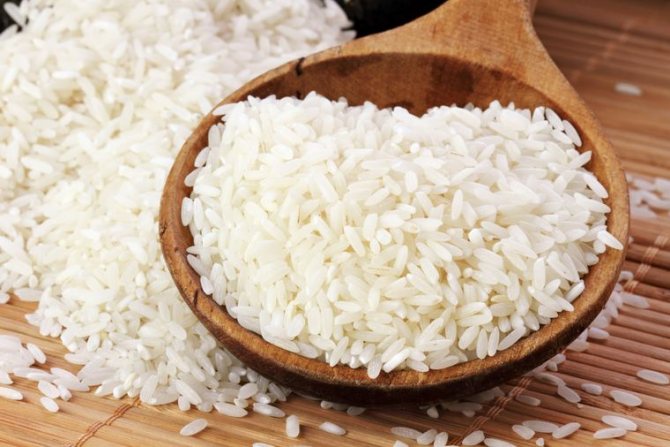
Rice is especially noteworthy for its high content of silicon (4133% of daily intake in 100 grams), manganese (182% of daily intake in 100 grams), cobalt and copper (about 50% of daily intake in 100 grams).
Meatballs. If you are watching your figure, choose minced chicken for making meatballs. The calorie content of meatballs with rice in tomato sauce is about 154 kcal.
Pumpkin porridge with rice. Pumpkin porridge is prepared with water or milk. If you cook it with milk, pay attention to its fat content. Thus, the calorie content of pumpkin porridge with milk (3.2% fat) with sugar is 120 kcal.
Chicken soup with rice. The energy value of this hot dish is only 90 kcal per 100 g.
We suggest you familiarize yourself with the hip reduction in the simulator
Crab salad with rice. The calorie content of crab salad with rice increases if you add fatty mayonnaise to it (150-170 kcal per 100 g). If you want to make the salad less high in calories, season it with low-fat sour cream (10-15% fat content - 23-31 kcal per 20 g). The calorie content of the salad will be 135–150 kcal.
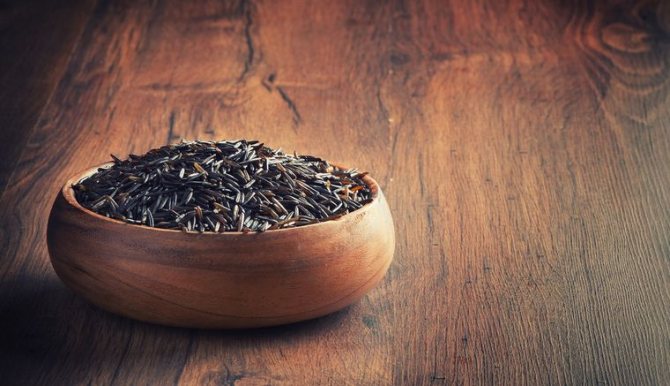
Stuffed cabbage rolls with meat. The calorie content of cabbage rolls with minced pork and beef and rice is 230 kcal.
Losing weight on rice
Rice is the basis of many weight loss diets. There are a number of reasons for this:
- The lowest calorie content among all known grain crops;
- Contains a lot of useful and necessary substances for existence;
- Has the property of removing water and toxins from the body;
- Does not contain gluten, which can cause an allergic reaction;
- Thanks to its high saturation with complex carbohydrates, it maintains tone and a feeling of fullness for 4 hours.
All this makes it an excellent tool for losing weight and leading a normal lifestyle that does not jeopardize a person’s health and well-being. The only exception is mono-diets, which are basically harmful regardless of what product they include.
Calorie content of rice types
Today, there is such a wide variety of rice varieties on store shelves that it’s dizzying! Among them are basmati, red, steamed white and others.
| Type of rice | Calorie content, kcal |
| White round grain | 344 |
| Brown | 337 |
| Wild | 357 |
| Red | 362 |
| White long grain | 365 |
| Basmati | 342 |
| White long grain steamed | 341 |
| Air | 402 |
| For sushi | 350 |
Based on the calorie content of different varieties of rice, you can combine a variety of dishes: for example, you can serve fatty fish as a side dish with less high-calorie wild rice, and boiled chicken meat with more high-calorie long-grain rice.
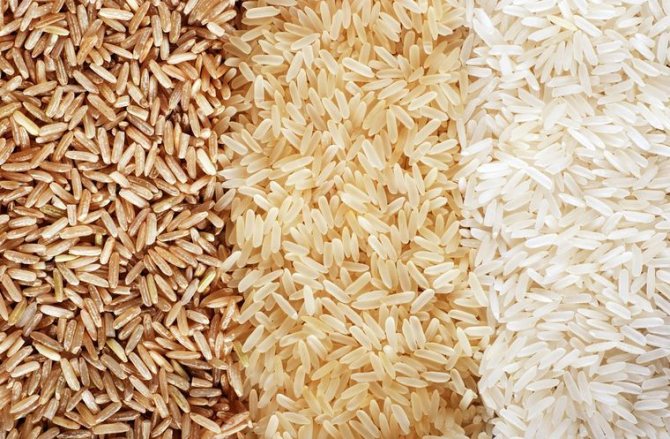
The calorie content of brown rice depends on the cooking method:
- the raw product contains about 337 kcal per 100 grams;
- boiled – 110 kcal per 100 g;
- if butter is added to the finished dish, the calorie content increases by another 23 kcal.
If you are trying to lose weight, dark rice is the best product because it has a lower glycemic index than other varieties. The glycemic index (Gl) is determined for carbohydrate foods and shows the rate at which energy is released from food. The higher Gl, the faster carbohydrates are absorbed into the blood, causing fluctuations in sugar levels.
Brown rice grains help speed up metabolism due to their high protein content. The product contains manganese, which helps synthesize fat. One bowl of brown rice is considered an ideal side dish during weight loss. But you should not include only grain products in the menu: their abuse will not only not lead to the desired forms, but can also disrupt the functioning of the gastrointestinal tract.
We suggest you familiarize yourself with what foods lower blood sugar
Tips for choosing rice
When choosing rice, the most important thing is to purchase a quality product that can be eaten without fear. Normal rice (if it is peeled) is dull white, slightly transparent. If it looks like this, then there is no risk of purchasing a rice substitute made from starch.
It happens that in a pack you come across white, chalk-like grains of rice - this is unripe rice. Also, you should not take packages that contain a lot of cracked grains of rice, because they will boil faster than the rest and ruin the dish.
The rice should not have a yellowish tint. Otherwise, it means it was most likely stored in damp conditions. And moisture stimulates the development of various fungi in it, which can release harmful toxins. The exception in this case is steamed rice. But it can be distinguished from spoiled one, since after the steaming procedure it acquires a slight darkish tint, and not light yellow.
It is also important to understand which type of rice is best suited for preparing a particular dish. According to shape and size, it is divided into round-grain, medium-grain and long-grain. When planning to cook porridge, soup with milk or sushi, it is better to stock up on round grains. Medium grain is suitable for risotto and soups. And for pilaf – long grain. This all has to do with their consistency and speed of cooking.
In terms of taste, brown rice, especially in the case of black and wild rice, is most suitable for salads. And aromatic rices, such as basmati, grown in India and Pakistan, or jasmine, cultivated in Vietnam, Cambodia and Thailand, are best for preparing aromatic dishes with rich flavor.
Boiled
The calorie content of 100 g of raw and 100 g of cooked rice differs significantly due to the fact that during cooking the grains absorb water. Accordingly, the mass increases. Thus, 100 g of boiled white rice without additives contains only 116 calories, 100 g of boiled brown rice has a calorie content of 110 calories, 100 g of boiled unpolished rice contains 125 calories, and 100 g of boiled wild rice contains only 78 calories.
We suggest you read: Is it possible to eat eggs with proper nutrition?
As a rule, salt, butter, raisins are added to rice or boiled in milk. To calculate the calorie content of supplements, consider the amount of ingredients. If this concerns milk, pay attention to its fat content. Salt will not add calories, since its energy value is zero. But a large amount of salt can provoke fluid retention in the body and, as a result, stress on the kidneys and swelling.
100 g of butter contains 748 calories. By adding only 3 g of butter to a dish, you will increase its calorie content by 23 calories. If you like rice with raisins, remember: the calorie content of 100 g of raisins is 264 calories. 15 g of raisins will increase the calorie content of your dish by 40 calories, and 1 teaspoon of sugar - by 16.
Calorie content of rice
The calorie content of rice directly depends on its variety and cooking method. The highest energy value is contained in puffed rice and cereals based on it, over 400 kcal. Raw rice also has a high energy value, averaging 348 kcal.
Cooked, unpolished or black, rice is a medium calorie food. But Shirataki rice is practically calorie-free - 9 kcal per 100-gram serving.
The nutritional value of rice is based on the high content of carbohydrates (65 grams), fats (2.9 grams), and proteins (10.8 grams).
